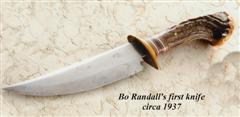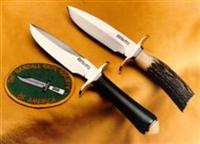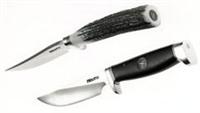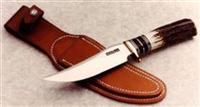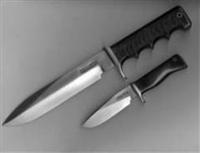
Knife Enthusiast

Registered: 10/15/05
Posts: 1649
Loc: Boogie Wonderland
|
Thanks to all who have participated thus far. From Randall Made Knives: The History of the Man and the Blades by Robert L. Gaddis, pp. 171-185 Quote:
For Bo, this all began on 25 November 1959 when two well-groomed men in casual attire showed up at the knifeshop beside his home. Later, when questioned about the visit, Bo remembered that the two were interested in a special knife with about a 5-inch, or at most 6-inch, blade. It had to be very strong, which wasn't any problem at this knifeshop, but it also had to be capable of storing a few itmes in a compartment of the handle. "Nobody's ever seen a knife like that!" Bo replied.
Then the men introduced themselves as Capt. Leroy Gordon Cooper, Jr., and Dr. William K. "Bill" Douglas from the National Aeronautics and Space Administration (NASA) Space Task Group. Suddenly realizing that he was talking to one of the well-publicized American astronauts and their team doctor, Bo "liked to have dropped dead!"
After regaining his composure, Bo brought out one of his Model 15 Airmen knives and related the story about its development for the Marine Corps as a pilot's survival knife. It was readily apparent to the NASA men that this design already came very close to meeting their requirements and that Bo was exactly the knifemaker they sought....
Besides looking over a finished Model 15 knife, Cooper and Douglas inspected some Solingen blades, without hilts or handles. At this point, all assumed the final knife would be carried on the space suits, so size and weight were major considerations. They discussed thinning the entire blade and probably the idea of a hiltless design also. Cutting out the center part of the tang would both reduce weight and creaet a cavity for matches and/or other small survival items. They ruled out the Model 15's green Tenite handle and considered the concept of a handleless style, with the blade tang wrapped in tape and fishing line....
This November 1959 visit was the first of numerous trips to the Randall knifeshop and residence. Between trips, they exchanged ideas and some experimental hardware by mail, and considered many alternatives before making their final decision. During this time, the Randall family hosted a number of the astronauts and became real friends in the process.
...By then, the guardless style was out, and the requirements for an extra-strong double hilt appeared to be in force. The sketch showed a relatively short 2 1/4-inch double hilt with reinforcing bolsters behind it. There was even a short bolt and nut through the bolsters and blade tang for added strength. A metal clip, 1 1/4 inches long, was shown over the blade point, extending back to cover the upper part of the blade tip. Pointing to this, a note, in writing not Bo's, stated: "Some type of clip that will clip over point for cutting suit after making hole with point." This one was sketched without handle slabs, and another handwriting added: "Could put small hacksaw blade under tape on handle." This effort was just another step along the path to their final knives....
On 25 May, Bo thought of something they all had missed and wrote to Cooper the next day. "Why not," asked Bo, "use stainless steel for the hilt to be certain of strength, then have it electrically welded in place? This will be sure of the hilt; also will have that much more room behind hilt for packing in items. O.K.?" He then drew a rough sketch of his idea on the following page of this letter. Later on that same day, he must have become convinced that this was the way to solve their hilt problems because he made a full-scale drawing of the hilt and tang portion of the Astro Knife, titling it "Astro Knife Handle Layout."
...On 6 December 1963, Cooper, accompanied by a Gemini Program astronaut, Tom Stafford, paid a surprise visit to the Randall residence. Bo was outside in the yard attending to some bit of business when they drove up unexpectedly. The two men stood talking for a few minutes by the front porch, when suddenly, and with any fanfare, Cooper reached into his pocket and brought out his Astro knife, the one that had been with him on his historic flight. He handed it to Bo, saying something to the effect that Bo had done so much for him and the other astronauts that he wished him to have this "space knife" as a personal thank you.
Bo said that he wasn't quite sure of Cooper's exact words because at the time he was overcome by emotion. Of all the knives in his extensive collection, this always was the one as far as Bo Randall was concerned. It was not placed in the museum until after his death. Bo kept it at home, in a specially made glass case.
The space program was such an important part of American history. President Kennedy's challenge to put a man on the moon and the space race with the Soviet Union inspired American astronauts and engineers to extraordinary feats. From the early Mercury program through John Glenn's historic orbit of the earth through the tragic deaths of White, Grissom and Chafe during the Apollo program through the moon landings, these men and women have persevered to bring us today to the space shuttle, the international space station and beyond. President Kennedy's challenge was fulfilled when Armstrong, Aldrin, and Collins landed on the moon July 20, 1969. As Neil Armstong said, "That's one small step for man, one giant leap for mankind."
Lady and gentlemen, let's light this candle.
Kevin
_________________________
Genesis 27:3
BSC-002
|


